The Cloud Compliance Market is estimated to be valued at USD 46.5 billion in 2025 and is projected to reach USD 173.3 billion by 2035, registering a compound annual growth rate (CAGR) of 14.1% over the forecast period.
The cloud compliance market is expanding rapidly as organizations prioritize regulatory adherence and data protection in increasingly complex cloud environments. The proliferation of SaaS applications, multi-cloud deployments, and cross-border data flows has heightened the need for continuous compliance monitoring. Enterprises are investing in automated compliance tools to ensure adherence to frameworks such as GDPR, HIPAA, and ISO standards.
The market benefits from the rising frequency of cyber incidents and growing scrutiny from regulatory authorities. Integration of AI and machine learning is enhancing anomaly detection, audit readiness, and risk mitigation.
Vendors are developing flexible solutions that adapt to industry-specific compliance needs. As businesses continue their digital transformation, ensuring data integrity and governance across distributed systems remains a strategic imperative, driving sustained growth in the cloud compliance market.
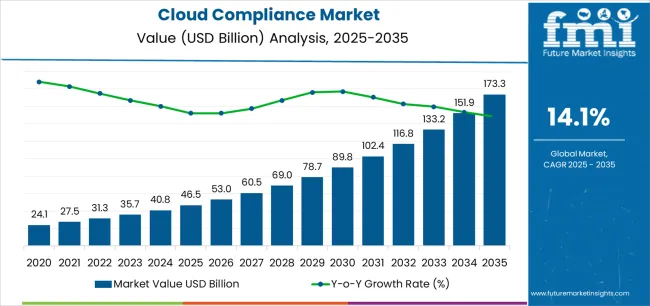
| Metric | Value |
|---|---|
| Cloud Compliance Market Estimated Value in (2025 E) | USD 46.5 billion |
| Cloud Compliance Market Forecast Value in (2035 F) | USD 173.3 billion |
| Forecast CAGR (2025 to 2035) | 14.1% |
The market is segmented by Component, Cloud Model, Application, Organizational Size, and Vertical and region. By Component, the market is divided into Software and Services. In terms of Cloud Model, the market is classified into Software-As-A-Service (SaaS), Platform-As-A-Service (PaaS), and Infrastructure-As-A-Service (IaaS). Based on Application, the market is segmented into Audit And Compliance Management, Threat Detection And Remediation, Activity Monitoring And Analytics, and Visibility And Risk Assessment. By Organizational Size, the market is divided into Large Enterprises and Small And Medium Enterprises. By Vertical, the market is segmented into Banking, Financial Services, And Insurance (BFSI), Government, Healthcare, IT And ITeS, Retail And E-Commerce, Manufacturing, and Utilities. Regionally, the market is classified into North America, Latin America, Western Europe, Eastern Europe, Balkan & Baltic Countries, Russia & Belarus, Central Asia, East Asia, South Asia & Pacific, and the Middle East & Africa.
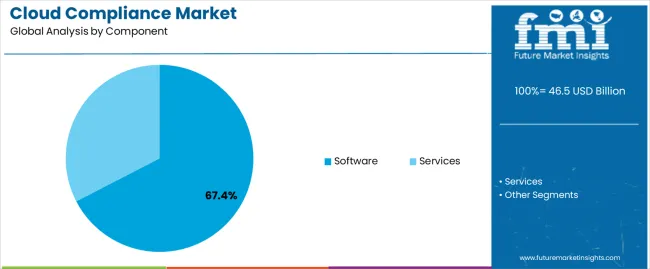
The software segment leads the component category with approximately 67.4% share, driven by increasing enterprise reliance on automated compliance management systems. Software solutions provide real-time policy enforcement, threat detection, and reporting capabilities that streamline regulatory adherence.
Organizations favor software-based tools for scalability, integration flexibility, and cost efficiency. Continuous updates aligned with evolving global regulations enhance their long-term value proposition.
With the growing complexity of cloud infrastructure and data privacy requirements, the software segment is expected to maintain its strong market dominance.
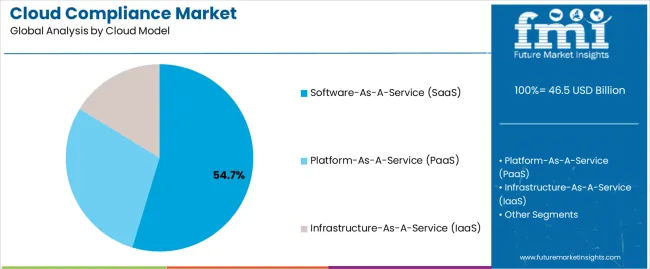
The Software-as-a-Service (SaaS) segment dominates the cloud model category with approximately 54.7% share. This leadership is attributed to its subscription-based accessibility, lower deployment costs, and ease of integration across multi-cloud environments.
SaaS-based compliance solutions offer real-time visibility into regulatory posture, supporting continuous monitoring and automated remediation. Enterprises prefer this model for its scalability, remote accessibility, and reduced IT maintenance burden.
With increasing adoption of cloud-first strategies and growing demand for agile compliance frameworks, the SaaS segment is poised to sustain its leading position.
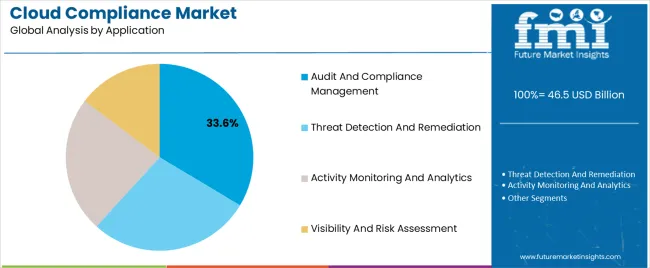
The audit and compliance management segment accounts for approximately 33.6% share of the application category. This segment’s growth is supported by heightened regulatory enforcement and the need for proactive compliance validation.
Automated audit trails, documentation, and risk assessment tools are enhancing transparency and accountability across cloud ecosystems. The segment benefits from demand across sectors such as BFSI, healthcare, and government, where data protection standards are stringent.
As organizations aim to streamline internal governance and external audit readiness, the audit and compliance management segment is expected to remain a key contributor to market growth.
Growing Focus on Data Privacy is a Key Market-shaping Trend
Global demand for cloud compliance solutions grew at a CAGR of 18.6% from 2020 to 2025. Total market valuation at the end of 2025 reached around USD 34.4 billion. In the assessment period, the market for cloud compliance software and services is projected to advance at 14.8% CAGR.
The global cloud compliance market share has grown rapidly during the historical period. This was mostly due to factors like increased reliance on cloud services, work-from-home trends, and heightened data security concerns.
Over the forecast period, the global cloud compliance industry is projected to expand at a healthy CAGR, attaining a colossal valuation of USD 173.3.0 billion by 2035.
This growth will likely be fueled by factors like the rising number of cyberattacks and data breaches, the implementation of stringent data privacy regulations, and the growing adoption of advanced technologies like cloud computing.
Amid rapid digital transformation and evolving landscape, small and medium-sized enterprises (SMEs) are increasingly adopting cloud computing. This is because it eliminates the need for investing in separate infrastructure.
SMEs, however, lack the resources and expertise to comply with complex data privacy regulations. This is creating demand for cloud compliance solutions specifically designed for small and medium-sized enterprises, thereby fostering market growth.
| Particular | Value CAGR |
|---|---|
| H1 | 14.5% (2025 to 2035) |
| H2 | 14.7% (2025 to 2035) |
| H1 | 15.3% (2025 to 2035) |
| H2 | 14.6% (2025 to 2035) |
The table below highlights the cloud compliance market revenue in top nations. The United States, China, and Japan are projected to remain the top three markets for cloud compliance solution providers, with expected valuations of USD 173.3 billion, USD 26.2 billion, and USD 18.1 billion, respectively, in 2035.
| Countries | Projected Cloud Compliance Market Value (2035) |
|---|---|
| United States | USD 173.3 billion |
| China | USD 26.2 billion |
| Japan | USD 18.1 billion |
| South Korea | USD 10.6 billion |
| United Kingdom | USD 6.6 billion |
The below table shows the estimated growth rates of the top countries. South Korea, Japan, and the United Kingdom are set to record high CAGRs of 17.0%, 16.0%, and 16.2%, respectively, through 2035.
| Countries | Expected Cloud Compliance Market CAGR (2025 to 2035) |
|---|---|
| United States | 14.9% |
| China | 15.5% |
| Japan | 16.0% |
| South Korea | 17.0% |
| United Kingdom | 16.2% |
As per the latest analysis, the United States cloud compliance market size is anticipated to reach USD 173.3 billion in 2035. It will continue to dominate the global market, with overall demand for cloud compliance software and services rising at a 14.9% CAGR throughout the forecast period. Some of the key drivers/trends include:
The United States has been the leader in cloud adoption for the last ten years. Businesses in the nations are increasingly moving their operations to the cloud to benefit from cost-efficiency, flexibility, and scalability.
The rising adoption of cloud services is leading to a growing need for compliance solutions to ensure that data and processes comply with regulatory standards. This, in turn, will likely provide impetus for the growth of the cloud compliance market in the United States.
The United States is also witnessing increasing data breaches, making businesses more aware of the need to protect their data. This is expected to uplift demand for cloud compliance solutions, which help companies secure their data and comply with regulations.
China’s cloud compliance market is poised to exhibit an impressive CAGR of 15.5% during the assessment period. By 2035, the total market valuation in the country is projected to reach USD 26.2 billion, driven by factors like:
China-based businesses are becoming concerned about data security amid growing cyberattacks and data breaches and the presence of cloud compliance standards. This is creating demand for cloud compliance solutions, which help them protect their data and mitigate these risks.
Another key factor expected to improve China’s cloud compliance market share is the rising adoption of novel technologies, including artificial intelligence (AI) and cloud computing.
These technologies necessitate compliance solutions that can keep pace with changing regulatory requirements as well as technological advancements.
Japan’s cloud compliance market is projected to thrive at a CAGR of 16.0% during the forecast period, totaling a valuation of USD 18.1 billion by the end of 2035. This is attributable to factors like:
Japan has enforced various strict data privacy regulations, including the Act on the Protection of Personal Information (APPI). These regulations necessitate businesses to employ strong data security measures, which will likely continue to drive demand for cloud compliance solutions.
There is also a growing preference for data residency in Japan. This is expected to create demand for cloud compliance solutions that facilitate local data storage and address data residency requirements in the country during the assessment period.
The section below offers profound insights into top segments and their respective growth rates for the assessment period. The software segment is set to grow at a robust CAGR of 14.6% during the forecast period. By the cloud model, the infrastructure-as-a-service (laaS) segment will likely thrive at 14.4% CAGR through 2035.
| Top Segment | Software (Component) |
|---|---|
| Estimated CAGR (2025 to 2035) | 14.6% |
As per the latest analysis, cloud compliance software will likely remain highly popular among end users. The target segment is expected to grow at a healthy CAGR of 14.6% during the assessment period. This can be attributed to the multiple benefits of cloud compliance software.
Cloud compliance software is gaining wider popularity among businesses as it ensures regulatory standards and provides compliance controls for networks and infrastructure. It helps businesses enhance visibility over network flows and cloud workloads and protect against container threats, server malware, and network intrusion.
| Top Segment | Infrastructure-as-a-Service (laaS) (Cloud Model) |
|---|---|
| Estimated CAGR (2025 to 2035) | 14.4% |
Based on the cloud model, the infrastructure-as-a-service (laaS) segment is projected to record a CAGR of 14.4% during the forecast period. This is because IaaS offers several advantages when it comes to security, data privacy, and regulatory adherence.
Infrastructure-as-a-service (laaS) model provides a high level of control and flexibility for security measures and compliance with specific regulations. It allows access to infrastructure for deep-level security audits and customization, making it popular among businesses.
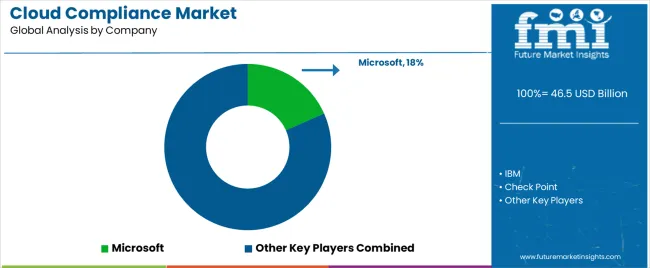
Key cloud compliance solution providers are focusing on expanding their offerings by launching new solutions, including data loss prevention (DLP), cloud security posture management (CSPM), and cloud access security broker (CASB) solutions.
They also use strategies like mergers, partnerships, acquisitions, alliances, and collaborations to boost their revenue and expand their footprint.
Recent Developments in the Cloud Compliance Market
| Attribute | Details |
|---|---|
| Estimated Market Value (2025) | USD 46.5 billion |
| Projected Market Value (2035) | USD 173.3 billion |
| Anticipated Growth Rate (2025 to 2035) | 14.1% CAGR |
| Forecast Period | 2025 to 2035 |
| Historical Data Available for | 2020 to 2025 |
| Market Analysis | Value (USD billion) and CAGR for 2025 to 2035 |
| Key Regions Covered | Latin America; North America; Western Europe; Eastern Europe; South Asia and Pacific; East Asia; and Middle East & Africa |
| Key Countries Covered | Canada, United States, Mexico, Brazil, Chile, Peru, Argentina, Germany, France, Italy, Spain, United Kingdom, Netherlands, Belgium, Nordic, Russia, Poland, China, Japan, South Korea, India, Thailand, Malaysia, Indonesia, Singapore, Australia, New Zealand, GCC Countries, South Africa, Central Africa, and others |
| Key Market Segments Covered | Component, Cloud Model, Application, Organizational Size, Vertical, and Region |
| Key Companies Profiled | Microsoft; IBM; Check Point; AT&T; Broadcom; Qualys; Nutanix; Sophos; Oracle; Palo Alto Networks |
The global cloud compliance market is estimated to be valued at USD 46.5 billion in 2025.
The market size for the cloud compliance market is projected to reach USD 173.3 billion by 2035.
The cloud compliance market is expected to grow at a 14.1% CAGR between 2025 and 2035.
The key product types in cloud compliance market are software, _cloud security posture management, _cloud workload protection platform, _cloud access security broker, _cloud native application protection platform, services, _managed services and _professional services.
In terms of cloud model, software-as-a-service (saas) segment to command 54.7% share in the cloud compliance market in 2025.






Full Research Suite comprises of:
Market outlook & trends analysis
Interviews & case studies
Strategic recommendations
Vendor profiles & capabilities analysis
5-year forecasts
8 regions and 60+ country-level data splits
Market segment data splits
12 months of continuous data updates
DELIVERED AS:
PDF EXCEL ONLINE
Cloud ERP Industry Analysis in Latin America Forecast Outlook 2025 to 2035
Cloud Backup Service Industry Analysis in Latin America Size and Share Forecast Outlook 2025 to 2035
Cloud-Based ITSM Market Size and Share Forecast Outlook 2025 to 2035
Cloud IT Infrastructure Hardware Market Size and Share Forecast Outlook 2025 to 2035
Cloud POS Market Size and Share Forecast Outlook 2025 to 2035
Cloud Systems Management Software Market Size and Share Forecast Outlook 2025 to 2035
Cloud Telephony Services Market Size and Share Forecast Outlook 2025 to 2035
Cloud Field Service Management (FSM) Market Size and Share Forecast Outlook 2025 to 2035
Cloud Seeding System Market Size and Share Forecast Outlook 2025 to 2035
Cloud Professional Services Market Size and Share Forecast Outlook 2025 to 2035
Cloud Based Collaboration Software Market Size and Share Forecast Outlook 2025 to 2035
Cloud Printing Services Market Size and Share Forecast Outlook 2025 to 2035
Cloud Migration Service Market Size and Share Forecast Outlook 2025 to 2035
Cloudifier Market Size and Share Forecast Outlook 2025 to 2035
Cloud Database and DBaaS Market Size and Share Forecast Outlook 2025 to 2035
Cloud ERP Market Size and Share Forecast Outlook 2025 to 2035
Cloud Computing Market Size and Share Forecast Outlook 2025 to 2035
Cloud Billing Market Size and Share Forecast Outlook 2025 to 2035
Cloud Access Security Brokers Market Size and Share Forecast Outlook 2025 to 2035
Cloud Storage Industry Analysis in MENA Size and Share Forecast Outlook 2025 to 2035

Thank you!
You will receive an email from our Business Development Manager. Please be sure to check your SPAM/JUNK folder too.
Chat With
MaRIA